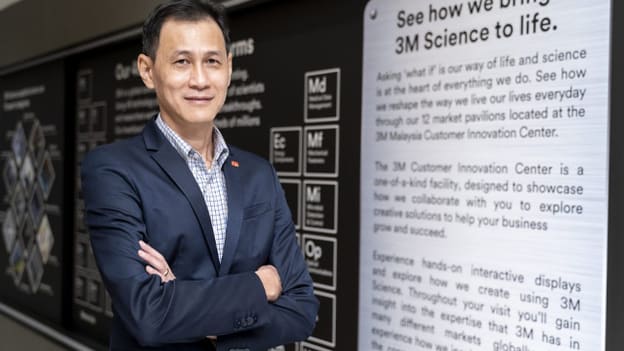The factors that feed reinvention: 3M's GT Lim

Collaboration driven by inclusion; a keen awareness of megatrends, how they affect what a company does, and what the company can do in response; proactive observation of how the surrounding community develops. People Matters asked GT Lim, Country Leader of 3M Malaysia Sdn. Bhd, about reinvention from the perspective of a company that prides itself on a culture of innovation. Here's what he shared.
The speed of innovation and reinvention has dramatically accelerated in recent years, perhaps faster than organisations are able to implement new changes. As the leader of a highly innovation-centric organisation, could you share some thoughts on what innovation and reinvention means when the pace of change is so great?
In the last year, we have seen a dramatic shift in the way we work. Many companies have jumped on the work-from-home bandwagon and are continuing to do so today, while some are adopting a hybrid system, and others, slowly transitioning back to the workplace.
Regardless of the changes, companies should work towards ensuring that all employees feel included, valued, and empowered to contribute their unique perspective and strength. This is because inclusion fosters creativity and collaboration, which leads to innovation that essentially contributes to the company’s success.
While we continue to encourage employees to work from home, employees who require access to the office facilities for achieving innovative and collaborative work are allowed to go back to the workplace in phases. The way we collaborate with each other, with customers and other stakeholders is central as it leads us to share lessons from success and obstacles encountered which affects the way we approach innovation. It also allows us to take our scientific capabilities and create differentiated solutions that help improve people’s lives—from protecting construction workers on the job to preventing infections at hospitals and helping revolutionise the transportation system.
We constantly see predictions that this or that trend will become the next big thing. But how can we turn such predictions into a long-term reality?
Trends are good to gauge the general direction in which something is developing and changing, but it often can also be interpreted in numerous ways. Hence, it is always important to analyse the trends and identify solid insights before we act. At 3M, we have consulted external sources to identify megatrends because while events such as the pandemic will cause short-term headwinds to some trends we see today, and tailwinds to others, we expect the longevity of megatrends to persist.
We believe the megatrends—technological breakthroughs; changing climates and resources; shifting demographics and social change; the rebalancing world; and the rise of the individual, are persisting forces that shape the world around us. Therefore, 3Mers constantly encourage each other to imagine what the world will look like in the next decade and beyond.
We ask ourselves, how can we invest in these advanced technologies to cater to the rapidly advancing world; what can we do to address the unpredictable climate and depleting resources; how can we prepare for societal change; what must we do to keep a steady footing as the world recovers from this health crisis; and how should one respond to the rise of influence of individuals in order to thrive in the new environment. Answering these questions and tying them back to solid facts from research and development in close partnership with our customers and the marketplace, allows us to confidently move forward to invent and manufacture relevant solutions to serve customers from around the world, turning predictions into a long-term reality, without being afraid of setbacks on the path to success.
What’s a better way to leverage fast-paced changes and innovations for the economic recovery and beyond?
Start by looking into our communities and how they adapt to their dynamic lifestyle. People inspire innovations and leveraging on insights from those we have close working relationships with, 1-on-1, create new products that serve the people around us. Often, many of these changes happen around us; hence we need to be proactive to observe, identify and evaluate opportunities for growth.
The five megatrends that were mentioned earlier give us a head start, help us stay focused on making more informed decisions during our research and development, and guide our decision-making for the business.
Additionally, I would also like to highlight the importance of research and development for the future. Experimentations allow us to theorise, test and implement scientific knowledge, best brought to life with a team of experts.
Having the foresight to innovate something that doesn’t exist today requires the vision, imagination and collaboration between multidimensional and diverse teams. Having diverse perspectives and looking at products from every angle gives birth to game-changing innovation that lives up to the speed of change that we face today.
What policies and practices do you think should be prioritised this year or this decade, as companies change and evolve to keep up with the times?
We believe science drives innovations that help us keep up with the dynamics of our world. It’s important to be science-minded and by that, drive advocacy of science at the forefront of the organisation. For instance, we’ve appointed one of our top scientists, Dr. Jayshree Seth to be 3M’s first ever chief science advocate. By starting from the leadership point-of-view, we can cultivate a team that shares the same passion for science and innovation.
Another practice that is quintessential in this age is diversity. Game-changing innovations require vision, imagination and foresight. As team members transcend geographies, gender, culture and education, it’s more likely a disruptive innovation can prevail. When we want to encourage future scientists, we need to consider all backgrounds to enrich lives for everyone across the globe.
Education is also another important aspect to prioritise. The reality is that we are still facing a big STEM gap and efforts to address this starts with creating access to good education. Based on the findings from the global 3M State of Science Index, many were discouraged from pursuing STEM education in school because of various factors, including the lack of access to science classes, negative connotations for being associated as a Science student - they were told that science is for ‘geeks’ or ‘nerds’, as well as gender, ethnic, and racial discrimination. Therefore, we need to constantly challenge ourselves to find new and better ways to support diversity and inclusion in STEM and encourage those in the industry to share their love for science with the next generation of science leaders.
At 3M, diversity and inclusion is part of our DNA. We believe that a diverse and inclusive culture is one that supports and appreciates differences, and provides fair and equal opportunities for all. Inclusion leads to engagement, which fosters collaboration, creativity, and innovation that drives long-tern growth. I am proud to say that the array of innovative 3M products that you see today is the result of a diverse and inclusive culture. This shows that to keep up with times, companies cannot dismiss diversity and inclusion, neither should it only be a one-off initiative. Promoting D&I in the workplace is a constant work-in-progress and should be maintained and nurtured to guarantee effectiveness.
Could you share a bit about how 3M’s purpose has remained focused and/or evolved all these years? What some of the principles and practices that have driven the organisational purpose throughout?
At 3M, we have always been passionate about applying science to improve lives around the world. Our commitment to science includes continuously supporting the next generation of scientists and making STEM education accessible for all. As a global organisation, we leverage on our collective goal of creating new products that touch lives and make progress possible. To achieve this, our 51 technology platforms that range from adhesives and metamaterials to nanotechnology are shared and combined across the company to promote cross-collaboration and integration regardless of the business, geography, or scientific disciplines.
We also practise our “15 percent” culture which was instituted six decades ago and continues to anchors 3Mers today. This culture encourages a unique approach to innovation. Employees are encouraged to utilise 3M resources, build up a unique team and follow their insight in pursuit of problem-solving, and ultimately utilising 15 percent of their working time to do it. Our high-trust culture allows the team to ensure their day-to-day responsibilities are met while having the opportunity to be creative and challenge status quo without being afraid of setbacks on the path to success.
This interview was originally published in April 2021.
Image credit:Business Today














